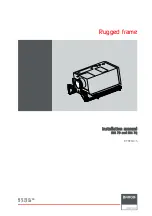
D12 Expert Series
page
3
Figure 2. Comparing placement of
switching thresholds for D12E
and D12E2 sensors
Max. Light Signal
D12E2 Threshold
(Excess gain = 1x)
Light Sensing
Condition
D12E Threshold
(Excess gain = 1x)
Min. Light Signal
Dark Sensing
Condition
D12E and D12E2 models set their sensing threshold points differently during the
TEACH mode process. D12E sensors automatically place the switching threshold just
above the dark condition that is taught to the sensor (see Figure 2). This scheme
works exceptionally well for sensing a very small sensing contrast, where the light
level represented by the dark condition remains constant. However, in some
applications, a subtle rise in the amount of light received in the dark condition may
prevent the D12E from responding to the intended sensing event.
D12E2 models automatically set the switching threshold at the mid-point between the
light and dark sensing conditions taught to the sensor (Figure 2). This mid-point
switching threshold allows D12E2 model sensors to ignore subtle changes in both the
light and dark sensing conditions. D12E2 models were first developed to ignore a
small amount of web flutter in high-speed registration color-mark-sensing applications.
At the end of the TEACH mode process, the D12 Expert bargraph indicator flashes one
to seven segments to indicate the relative sensing contrast (see page 8), so you know
how forgiving your application will be to changing sensing conditions.
SENSOR OUTPUT CONFIGURATION Mode
The OUTPUT CONFIGURATION PROGRAM mode allows you to set the sensor’s output
for either no delay or for a fixed 40 millisecond pulse stretcher (OFF-delay) for use
with loads (or circuit inputs) that are too slow to react to a quick event. With no OFF
delay, sensing response is a fast 200 microseconds (.0002 seconds) both ON and
OFF.
The output can also be configured for either light operate (LO) or dark operate (DO).
Light operate energizes the sensor’s load output when the light condition is sensed,
and dark operate energizes the load output for the dark condition.
The output configuration can be checked at any time by simply holding down the
push button for 2 seconds. The sensor’s 7-segment LED display will indicate the
current setting for 10 seconds (see Figure 3), while the sensor continues normal
operation. Factory settings for the output configuration are no delay (0 ms) and light
operate (LO).






























